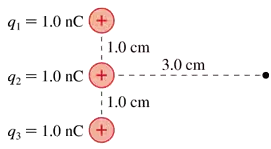 Back
BackProblem 61
An electric dipole consists of two opposite charges separated by a small distance . The product is called the dipole moment. Figure P shows an electric dipole perpendicular to an electric field . Find an expression in terms of and for the magnitude of the torque that the electric field exerts on the dipole.
Problem 64
The identical small spheres shown in FIGURE P22.64 are charged to +100 nC and −100 nC. They hang as shown in a 100,000 N/C electric field. What is the mass of each sphere?
Problem 65c
A 10.0 nC charge is located at position (x, y)=(1.0 cm, 2.0 cm). At what (x, y) position(s) is the electric field N/C?
Problem 66a
Three 1.0 nC charges are placed as shown in FIGURE P22.66. Each of these charges creates an electric field E at a point 3.0 cm in front of the middle charge. What are the three fields E₁, E₂, and E₃ created by the three charges? Write your answer for each as a vector in component form.
Problem 68
An electric field N/C causes the point charge in FIGURE P22.68 to hang at an angle. What is θ?
Problem 70a
Starting from rest, how long does it take an electron to move 1.0 cm in a steady electric field of magnitude 100 N/C?
Problem 71
A 5.0 g ball charged to 1.5 μC is tied to a 25-cm-long string. It swings at 250 rpm in a horizontal circle around a stationary ball charged to −2.5 μC. What is the tension in the string?
Problem 77
Space explorers discover an 8.7×1017 kg asteroid that happens to have a positive charge of 4400 C. They would like to place their 3.3×105 kg spaceship in orbit around the asteroid. Interestingly, the solar wind has given their spaceship a charge of −1.2 C. What speed must their spaceship have to achieve a 7500-km-diameter circular orbit?
Problem 78
A small 1.0 g block charged to 75 nC is placed on a 30° inclined plane. The coefficients of static and kinetic friction are 0.20 and 0.10, respectively. What minimum strength horizontal electric field is needed to keep the block from sliding down the plane?
Problem 80c
In Section 22.3 we claimed that a charged object exerts a net attractive force on an electric dipole. Let's investigate this. FIGURE CP22.80 shows a permanent electric dipole consisting of charges +q and −q separated by the fixed distance s. Charge +Q is distance r from the center of the dipole. We'll assume, as is usually the case in practice, that s≪r. Use the binomial approximation if x≪1 to show that your expression from part a can be written .





